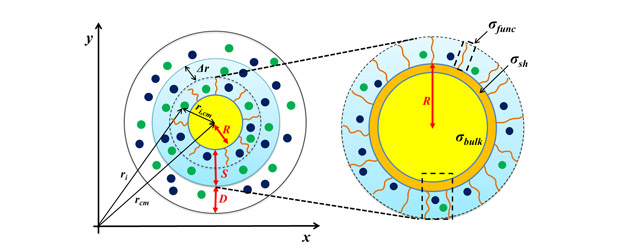Accueil
Anti-clumping strategy for nanoparticles (Vol. 47 No. 1)

Scientists identify the factors involved in preventing nanoparticles used in industrial applications from aggregating.
Nanoparticles are ubiquitous in industrial applications ranging from drug delivery and biomedical diagnostics to developing hydrophobic surfaces, lubricant additives and enhanced oil recovery solutions in petroleum fields. For such nanoparticles to be effective, they need to remain well dispersed into the fluid surrounding them. In a study published recently, the authors identified the conditions that lead to instability of nanoparticles and producing aggregates. This happens when the electric force on their surface no longer balances by the sum of the attractive or repulsive forces between nanoparticles.
L. S. de Lara, V. A. Rigo and C. R. Miranda, The stability and interfacial properties of functionalized silica nanoparticles dispersed in brine studied by molecular dynamics, Eur. Phys. J. B 88, 261 (2015)
[Abstract]
Cancer risk myth debunked (Vol. 47 No. 1)

© tilialucida / Fotolia
Cancer risk debate laid to rest by novel calculations distinguishing population-wide risks for each organ and individual risks linked to environmental and genetic factors.
A recent study suggests that variations in terms of cancer risk among tissues from various organs in the body merely amount to pure bad luck. In other words, cancer risk is linked to random mutations arising in the normal course of DNA replication of healthy cells. It is also claimed that environmental and genetic factors play a lesser role. The scientific community has primarily reacted negatively to this interpretation and promptly refuted it with qualitative arguments and empirical evidence. Joining these voices are the authors, who uncovered the statistical fallacy at the source of the recent study's conclusion. The key is to distinguish between individual organ risks and population risks, they wrote in this work. They also contend that the role of genetic and environmental factors must not be underplayed, even if these factors cannot explain differences in cancer rates between different organs.
D. Sornette and M. Favre, Debunking mathematically the logical fallacy that cancer risk is just “bad luck”, EPJ Nonlinear Biomedical Physics 3, 10 (2015)
[Abstract]
Lasing with topological defects (Vol. 47 No. 1)

A new laser based on a swirling vortex of light has been created by the authors. The ‘topological-defect laser’ could be a useful addition to lab-on-a-chip devices, where it could manipulate fluids and tiny particles. The design could also be modified to create beams of light with orbital angular momentum.
Conventional lasers confine light by bouncing it back and forth in an optical cavity made of two opposing mirrors. The authors have taken a new twist on this design by making an optical cavity that confines light by having it swirl around in a vortex. They made their optical cavity within a photonic crystal, which is a material containing a regular array of elements which are separated by distances on par with the wavelength of light. Light at certain wavelengths and travelling in certain directions will pass freely through a photonic crystal, whereas light not meeting these criteria will be diffracted into a new trajectory.
S. Knitter, S. F. Liew, W. Xiong, M. I. Guy, G. S. Solomon and H. Cao, Topological defect lasers, J. Opt. 18, 014005 (2016)
[Abstract]
Trapping climate pollutant methane gas in porous carbon (Vol. 47 No. 1)

New adsorption of gas into porous carbon simulations are of interest to energy research and climate change mitigation.
As talks of global warming are once again making headlines, scientists have renewed their efforts to understand how to best limit its effects. For example, sequestrating short-lived climate pollutants, such as methane and black carbon, yields much faster reductions in global warming compared to reductions in CO2. To do so, it is essential to have a better grasp of the nature of physico-chemical properties of gases interacting with porous carbon. Now, a team of chemical engineering researchers has established ways of accurately simulating methane adsorption and desorption in carbon with nanopores. These findings have been published recently. Alternative applications for such findings are relevant for future energy research, such as energy storage and the development of natural gas extraction methods.
M. Lasich and D. Ramjugernath, Influence of unlike dispersive interactions on methane adsorption in graphite: a grand canonical Monte Carlo simulation and classical density functional theory study, Eur. Phys. J. B 88, 313 (2015)
[Abstract]







